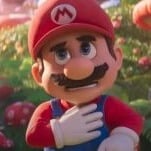The New Super Mario Bros. Movie Embraces the Dystopia the 1993 Super Mario Bros. Movie Warned About

After around seven years in development, The Super Mario Bros. Movie finally hits theaters next month.
The project has roots in Shigeru Miyamoto designing Universal’s Super Nintendo World, where the creator first met Illumination founder Chris Meledandri in 2016. Miyamoto saw a kinship in Meledandri’s creative process, and the two began to brainstorm a multi-movie enterprise. Fast-forward to 2023, and the final project—helmed by the two creative leads on Teen Titans Go! To The Movies—is primed to stomp the box office.
For a company that styles themselves after Disney, and a cable company who seeks a similar creative fiefdom, it’s a wet dream. Nintendo, in particular, has long aspired to have tight creative control over each and every aspect of their IP. The company has a lengthy, documented history of shuttering fan projects, hampering emulation efforts, and shutting down archival attempts. Like Disney, Nintendo does this in service of “magic”—an undefinable sense of immersion distinct from reality.
The Super Mario Bros. Movie looks to capitalize on that idea. It is slavishly on-brand, with little deviation or variation on designs we’ve spent two-plus decades internalizing. Ideally, a child could see the Mario movie, ask their parents for a Mario game, then eventually visit the Mario theme park and see little differentiation between all of it. This is brand synergy firing at all cylinders, and something Nintendo has aspired to since their monopolistic 1980s ambitions.
It’s also a course correction from one of their biggest perceived public missteps.
Rocky Morton and Annabel Jankel’s Super Mario Bros. hit American theaters exactly three decades ago this year. Popular opinion of the ambitious sci-fi take on the series has varied over the years. Depending on who you ask, it’s one of the worst movies of all time or a misunderstood cult gem. (Guess where I fall.) There’s one thing that can be agreed upon, however: it’s a very different animal from the videogames.
Mario ‘93 is isekai dystopian sci-fi drawn in equal parts from 1984, Brazil and Blade Runner. The central premise sees the two brothers square off against an AU Trump-esque villain, militaristic company man Koopa. Koopa holds a chokehold on the media, forbids protest music, and uses a private police force to keep people in check. Imagine theme park rules and regulations applied to a city—right down to Universal’s terrifying facial recognition software—and you’re halfway there.
Morton and Jankel frame this sort of tight governance, city planning, and media control as inherently villainous. Further, it leans heavily on pointing out the ecological destruction wrought by over-development. Fungus—a cornerstone of the Mushroom Kingdom—has been reduced to phlegmish growths through the city. Koopa has an overblown reaction to dirt and grime, too, as his germophobia is a central part in some of the film’s humor. Capital-driven development and uniformity, the film argues, are a rejection of reality.
Super Mario Bros. is a dark, scary film centered on the evils of capitalist monopolies. It also happens to be a derivative work from a monopolistic capitalist success story. Released as a different film altogether, Super Mario Bros. might not have received the hostile reaction it did from critics and the general public at large. Tied to the cartoon plumber kids recognized more than Mickey Mouse, however, it was almost always guaranteed to be a disaster.
-

- Our Favorite Game References in the Fallout TV Show Trailer By Matthew Reyes March 8, 2024 | 4:29pm
-

-



